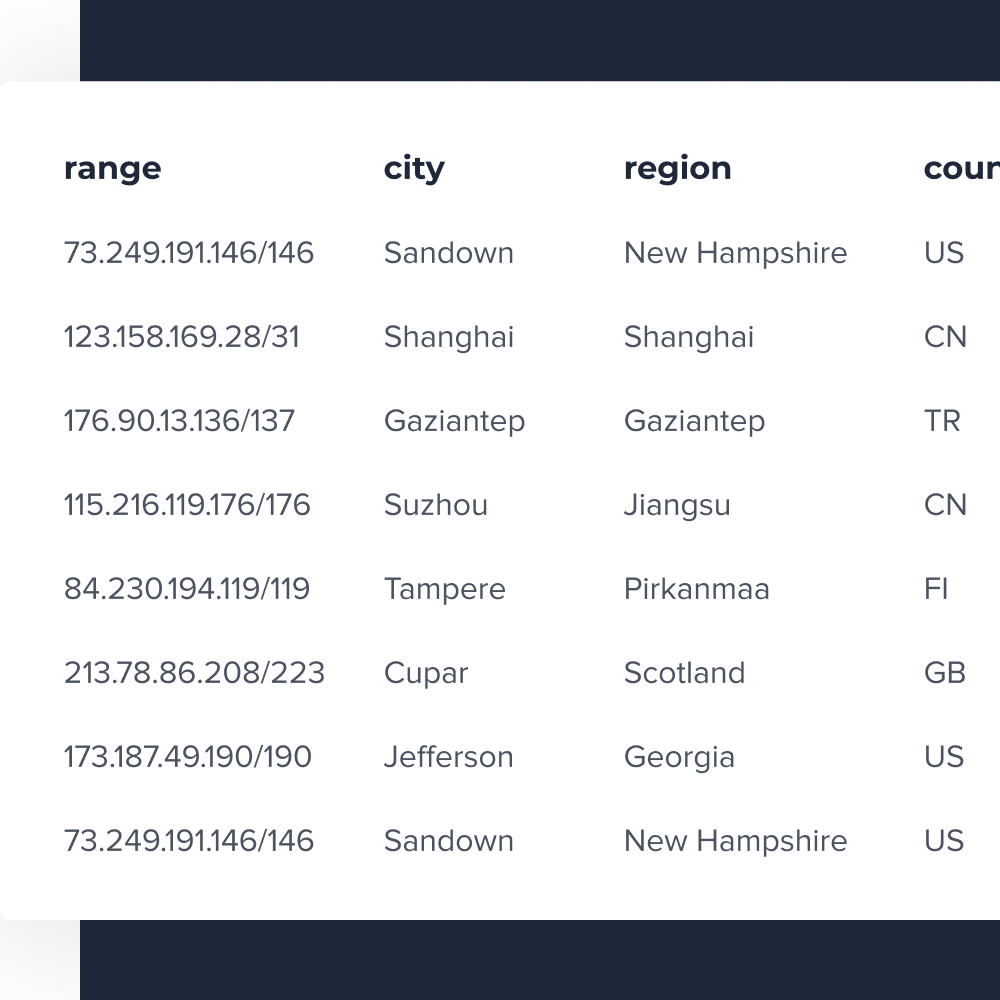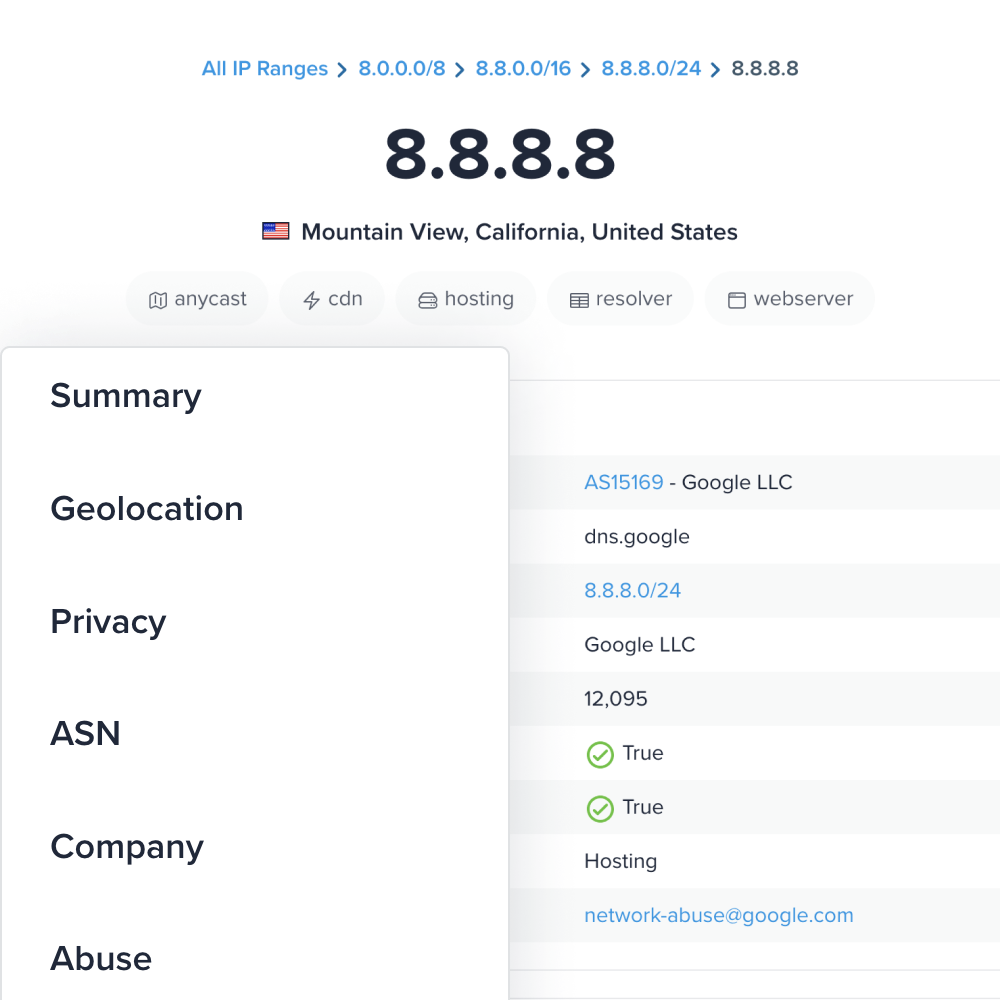Explore our IP Address Database Downloads for instant access to our IP address insights
Learn moreStatic vs. Dynamic IP Addresses

Understanding the distinction between static and dynamic IP addresses is important for making informed technical decisions. A static IP address remains constant, while a dynamic IP address changes periodically.
Internet service providers (ISPs) typically assign dynamic IP addresses for residential use because they are easier to manage and scale. However, for business environments that require consistent connectivity, reliable remote access, or hosting services, static IP addresses are more typical.
In this article, we’ll unpack the differences between static and dynamic IP addresses, outline their benefits, and highlight common use cases.
What Is a Static IP Address?
A static IP address is a fixed, unchanging IP address assigned to a device or network. Unlike dynamic IP addresses, which are automatically reassigned and can change over time, static IPs remain constant, even if the device disconnects or restarts.
Static IP addresses are essential for scenarios where a consistent address is critical. For instance, they’re commonly used to host websites and run servers, as a fixed IP ensures reliable connections for users accessing these services. Businesses also use static IPs to manage secure remote access, allowing employees or systems to connect seamlessly to internal networks without worrying about fluctuating addresses.
Additionally, in local area network (LAN) devices like network printers, security cameras, or IoT systems often benefit from static IPs because they require stable connectivity within a network. The unchanging nature of static IPs also makes them easier to trace, enhancing accountability and network management.
| Pros | Cons |
|---|---|
| Reliability: Ensure consistent anytime, anywhere access to servers, websites, and remote systems. | Higher Costs: Have additional fees from ISPs. |
| Stability: Reduce connection lapses. providing uninterrupted service. | Increased Risk of Targeting: Make businesses more susceptible to targeted cyberattacks. |
| Faster Performance: Facilitate faster download and upload speeds, ideal for hosting or large data transfers. | Post-Breach Risks: Once compromised, can be more challenging to secure compared to dynamic IPs. |
| Accurate Geolocation: Trace more easily to a specific location because it remains constant. | Limited Availability: Are harder to obtain because there’s a finite number. |
| Enhanced Security: Enable robust security configurations, such as firewalls or whitelisting for specific IPs. | Requires Expertise: Demands more technical knowledge for configuration and maintenance. |
Get accurate IP data for better cybersecurity
Accurate IP address data plays an integral role in delivering effective cyber security programs to combat modern-day threats.
Common Use Cases
- Hosting Websites and Servers: Ensures a stable connection for websites, applications, and online services, making them accessible to users without interruptions.
- Remote Access: Provides a consistent endpoint for employees or systems to securely connect to internal networks from anywhere. Learn more about an IP address for access control.
- IoT Devices and Smart Home Systems: Keeps devices like cameras, thermostats, and smart appliances reliably connected for seamless operation.
- VoIP Services: Offers uninterrupted communication with clearer call quality and minimal downtime.
- Game Servers: Facilitates smooth multiplayer gaming with consistent server access and minimal latency.
- Streaming and Media Hosting: Ensures reliable delivery of media content to audiences without buffering or service interruptions.
- Corporate Networks: Supports large-scale, secure connections between office locations or for enterprise-level applications.
- Email Servers: Guarantees that emails are delivered reliably and aren’t flagged due to changing IP addresses.
What Is a Dynamic IP Address?
A dynamic IP address is a temporary, regularly-changing address assigned to devices like laptops, smartphones, and home routers. Unlike static IPs, which remain constant, dynamic IPs are reassigned periodically by ISPs.
Dynamic IPs are widely used in environments with a large number of devices, such as residential networks, schools, and public Wi-Fi systems. They are ideal for setups where devices frequently connect and disconnect, simplifying network management and reducing the demand for unique IPs.
Dynamic IPs are ideal for everyday internet use, like web browsing, streaming, and connecting multiple devices at home. However, businesses relying on stable remote access, VoIP, or hosting services often find dynamic IPs less effective due to occasional downtime or connectivity issues.
| Pros | Cons |
|---|---|
| Lower Costs: Save money, as dynamic IPs are typically cheaper and included in standard ISP packages. | Less Stability: Cause issues for applications requiring a consistent IP address. |
| Easier Configuration: Make setup easier, as they are automatically assigned, reducing the need for manual configuration. | Hosting Problems: Are unsuitable for hosting websites, servers, or other consistent services. |
| More Flexibility: Offer more flexibility in networks with many devices connecting and disconnecting. | Less Technical Reliability: Tend to experience more downtime and connectivity issues than static IPs. |
| Streamlined Management: Simplify IP address management, especially for large-scale networks or businesses. | Complicated Remote Access: Are less reliable for remote access programs like VPNs. |
| Enhanced Security: Make it harder for hackers to target devices, as the IP address is constantly changing. | Limited Geolocation Accuracy: Traces less easily to a specific location because it remains constant. |
Common Use Cases
- Residential Internet Connections: Commonly used in homes, where devices like laptops, phones, and tablets connect and disconnect frequently.
- Mobile Devices: Ideal for smartphones and tablets that move between different networks and need an IP address that can change.
- Public Wi-Fi Networks: Used in cafes, airports, and other public spaces, where many users connect and disconnect regularly.
- Large-Scale Corporate Networks: Suitable for businesses that don't require fixed IPs for all devices, especially for employees accessing the internet on varying locations.
- Temporary Internet Use: Perfect for short-term or guest access, where devices need a temporary IP during a brief connection.
- ISPs: Enable ISPs to manage a large pool of IP addresses by reusing them for different customers.
- Load Balancing: Helps distribute traffic across multiple servers, allowing IP addresses to change for better resource allocation.
- Cloud Computing Services: Used for cloud instances that scale up or down frequently, requiring dynamic IP assignments.
- Shared Office Environments: Suitable for co-working spaces where devices from various users are connected at different times.
Comparing Static and Dynamic IPs
Understanding the differences between static and dynamic IP addresses is essential for selecting the right option, whether for personal browsing, professional remote access, or enterprise-level hosting and security.
Get more IP address info about what can be gathered from an IP address.
Differences
Static and dynamic IP addresses differ significantly in their functionality and applications. The assignment method is a key distinction: static IPs are manually configured and remain fixed, while dynamic IPs are automatically assigned and frequently change. This makes static IPs ideal for applications requiring stability and reliability, such as hosting servers or enabling remote access, while dynamic IPs excel in environments needing scalability, such as large networks or public Wi-Fi.
Dynamic IP addresses are also necessary because all 4.2 billion IPv4 addresses have been exhausted, and IPv6 adoption, which allows for 340 undecillion IP addresses, has been slow. Since dynamic IP addresses change, they better accommodate the demand for IP addresses.
Security varies between the two; dynamic IPs are harder for hackers to target due to their frequent reassignment, whereas static IPs are more vulnerable to persistent attacks, but also allow for more straightforward configuration of security access rules and firewalls.
Geolocation services tend to provide more accurate location data for static IP addresses. Since they don’t change, and the device using them is often less mobile than a laptop or cellphone, their locations remain more constant. Dynamic IP addresses fluctuate in both identification and location. Learn more about the factors that influence IP geolocation accuracy.
Lastly, setup and maintenance differ; static IPs require more effort and expertise to configure, whereas dynamic IPs streamline management by automating address allocation. These distinctions guide their use in various scenarios.
Similarities
Static and dynamic IP addresses share the key role of serving as unique identifiers for devices on a network, enabling seamless communication and internet connectivity. Both types, whether IPv4 or IPv6, operate using the same underlying protocols, ensuring compatibility with modern technologies and services like web browsing, email, and video streaming.
Regardless of their assignment method, they support similar applications, ensuring devices can send and receive data efficiently. Whether fixed or changing, static and dynamic IPs are integral to the smooth operation of networks, supporting connectivity in personal, professional, and enterprise environments.
Dynamic vs. Static IP Address Example
Should Companies Use Static or Dynamic IP Addresses?
The decision between static and dynamic IP addresses depends on a company’s specific needs and operational priorities. Static IPs are ideal for businesses requiring stability and reliability, such as hosting servers, enabling remote access, or running applications that demand a consistent address. These IPs ensure uninterrupted services and seamless connectivity for VoIP and VPN solutions, making them essential for organizations prioritizing security and operational efficiency.
Conversely, dynamic IPs are better suited for flexibility and scalability, particularly in environments with many non-critical devices or fluctuating connectivity needs. Large networks, such as in educational institutions or co-working spaces, benefit from the automatic reassignment and lower costs of dynamic IPs.
Get the most accurate IP data for your enterprise needs
Our database downloads give you flexibility with how you handle the data. Choose from multiple formats, cloud integrations, and download schedules.
Wrapping Up Dynamic vs. Static IP Addresses
Choosing between static and dynamic IP addresses ultimately depends on specific requirements, such as the need for stability, cost considerations, scalability, and security. Static IPs are ideal for businesses requiring reliable hosting or remote access, while dynamic IPs offer flexibility and cost-efficiency for large, dynamic networks.
With IPinfo’s API, you gain access to the most accurate and reliable IP data, regardless of whether users are on static or dynamic IPs. Our IP data provides precise geolocation, ASN information, and more, ensuring your business can make informed decisions and enhance online experiences.
Use the industry leading IP data API
Locate users, customize experiences, eliminate site risks, and much more.
About the author

Meghan is the content strategist at IPinfo, where she develops and writes content for users to better understand the value of IP data and IPinfo products.


